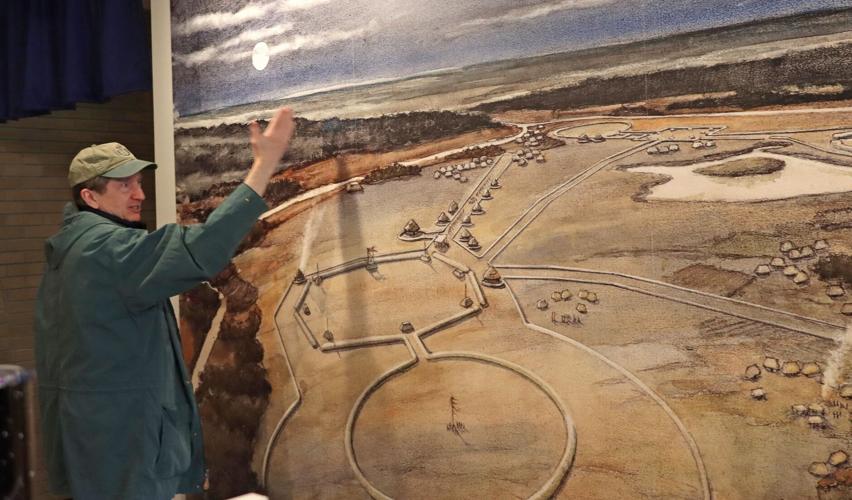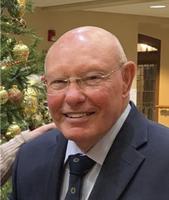Scattered over south and central Ohio are numerous human-made geometrical earthen shapes — circles, squares and octagons, that dot the landscape.
Scientists who’ve studied the structures believe that pre-Columbian Native Americans, members of the Hopewell culture, started building these formations some 2,000 years ago.
Thought to have been used by the indigenous peoples as places of burial, worship and social gatherings, one enclosure located near Newark, Ohio, about 30 miles east of Columbus, is the largest earthen enclosure in the world. The Great Circle enclosure is located in Heath, on the Newark line, while the Octagon enclosure is about a mile away in Newark.
In September 2023, the Newark Earthworks and five other earthwork clusters scattered nearly 100 miles across Ohio were given the status of a UNESCO World Heritage Site, making it the first such designation in the state. It’s also just one of 25 World Heritage Sites in the U.S. and one of more than 1,100 worldwide.
The Hopewell Ceremonial Earthworks, as the Ohio sites are called, are in good company, sharing the same status as Machu Pichu, the Acropolis and Stonehenge.
In late March, I visited the Newark Earthworks. After parking my car, I spotted a bronze plaque near the site’s small museum that shows the outline of the site which covers some 4 acres. The plaque is only one of several pieces of signage that dot the landscape and provide significant information on the earthworks for those who take a self-guided tour.
In the museum, I met with Brad Lepper, senior archaeologist for the Ohio History Connection’s World Heritage Program, who likened the site to a great cathedral where people from hundreds of miles away came to hold rituals and ceremonies due to its spiritual significance. Its immense size also served as a meeting place and a place for socializing and trading.
Because the earthworks served as ceremonial centers, finely crafted ritual objects such as effigy pipes, jewelry and pottery have been recovered. The museum has replicas of items found on the earthworks site that show the great geographic extent of the trade routes that extended from Colorado (obsidian) to Florida (sea shells) to the Appalachians (mica).
Citing several mathematical relationships between the different Newark structures, Lepper said the Hopewell culture was well advanced in mathematics and astronomy.
“The circumference of the Great Circle is equal to the perimeter of the square attached to it,” he said. “And the area of the square is equal to the area of the circle attached to the octagon.”
To show the relative size of the site, the 50-acre Octagon could hold four Roman coliseums, and the Great Circle, with a diameter of 1,200 feet, could hold 23 football fields.
To build the earthworks, the native population used pointed sticks and clam shell hoes to dig the earth, which they then carried on their shoulders in woven baskets that could hold up to 30 pounds.
The Newark Earthworks also had astronomical significance in that the 18.6-year lunar cycle is reflected in its construction. For instance, the central axis of the Octagon looks to the point on the horizon where the moon makes its northwesternmost rise at one end of the cycle.
Other earthworks sites in the Hopewell UNESCO-designated complex have solar alignments as well.
Back in the museum, visitors can see several displays related to the Hopewell culture including a three-minute introductory video and an interactive touchscreen kiosk that explores many germane topics.
On a tour of the grounds with Lepper and Sarah Hinkelman, site manager, I learned that the earthworks are the largest in the world not built for defensive purposes. “The Newark Earthworks are huge, encompass 4.5 square miles and the structures were connected by roads,” Lepper said.
Some of the Newark earthworks had walls as high as 14 feet and all had a deep ditch inside the enclosure. According to Bill Kennedy, site manager of Fort Ancient Earthworks and Nature Preserve, another of the earthworks sites in Oregonia in SW Ohio, its walls held the equivalent of 125 million baskets of soil.
As we walked around the Great Circle, we came to a central mound with a wing-like shape appropriately called the Eagle Mound. According to Hinkleman, the site is a commemorative mound that marked the place where a longhouse once stood and had a large central fire basin that had been cleaned out and filled with sand.
“We don’t know what the building had been used for,” Hinkelman said.
Unfortunately, the Hopewell culture started to disappear circa 400 CE and left no written records behind.
“Here at the Newark Earthworks, there’s no single place to capture the entire site such as at Stonehenge or the Taj Mahal,” Lepper said. “You have to immerse yourself in the site by walking through it to experience its grandeur.”
To get to the Octagon, we had to get in our car and drive about 1 mile to the site now occupied by the Moundbuilders Country Club. While access to the site for public touring is usually limited to four days a year, visitors can view the site (a 20-acre circle and the attached Octagon) at a raised platform. The Ohio History Connection is currently involved in buying back the country club lease in the hope of giving the public total access.
The OHC runs three of the earthworks sites, while the remaining five sites fall under the jurisdiction of the National Park Service.
In the late 1990s, experts in the field expressed a belief that the earthworks should have a UNESCO World Heritage Site designation, Over the next 20-plus years, organizers nominated the sites to UNESCO, engaged in a review process and submitted a naming document in 2021.
UNESCO then sent out a reviewer who visited all 8 sites in Ohio in five days. Finally, on September 19, 2023, the Earthworks nomination was approved.
Of the approved nomination, Glenna Wallace, chief of the Eastern Shawnee Tribe of Oklahoma said, “When I grew up my people were thought of as savages. Now, they’re thought of as geniuses.”
The Newark Earthworks are located at 455 Hebron Road in Heath, Ohio. For more information, phone 740-344-0498 or www.ohiohistory.org.
To add a related site to your visit, Flint Ridge Ancient Quarries is a 553-acre preserve where Native Americans came from the surrounding area to quarry the exceptional rainbow flint found there. Used for trading and to make weapons and tools, the flint is found in a nearly eight-mile-long vein of high-quality material.
Located three miles north of Brownsville, Ohio, and 11 miles from the Newark Earthworks, the preserve has numerous, sometimes water-filled quarry pits, a small museum, and 4-½ miles of walking trails.
For more information on Licking County attractions, log on to www.explorelc.org.
For a Place to Stay, the Doubletree by Hilton, 50 N.2nd St in Newark, is a block from Newark’s historic courthouse. Amenities include the hotel’s signature chocolate chip cookie, spacious rooms, an indoor swimming pool, full-service Starbucks, a 24-hour fitness center and free parking. Phone (740) 322-6455.
For a place to dine, try the historic Granville Inn, located at 314 E. Broadway in the charming village of Granville. Dine outdoors on the Tuscan-style patio built on flagstone floors protected by red umbrellas, in the rustic Oak Room with its inviting fireplace and large out-facing windows, or in the tavern with its central bar and copper-fronted fireplace.
The chef-inspired menu changes four times a year and features locally sourced foods. On a timely note, the inn is celebrating its 100th anniversary this year. To help them celebrate, order the restaurant’s popular Fedora Salad, named after the daughter of the original owner, famous for wearing a fedora. Phone (740) 587-3333 or Granvilleinn.com.














(0) comments
Welcome to the discussion.
Log In
Keep it Clean. Please avoid obscene, vulgar, lewd, racist or sexually-oriented language.
PLEASE TURN OFF YOUR CAPS LOCK.
Don't Threaten. Threats of harming another person will not be tolerated.
Be Truthful. Don't knowingly lie about anyone or anything.
Be Nice. No racism, sexism or any sort of -ism that is degrading to another person.
Be Proactive. Use the 'Report' link on each comment to let us know of abusive posts.
Share with Us. We'd love to hear eyewitness accounts, the history behind an article.